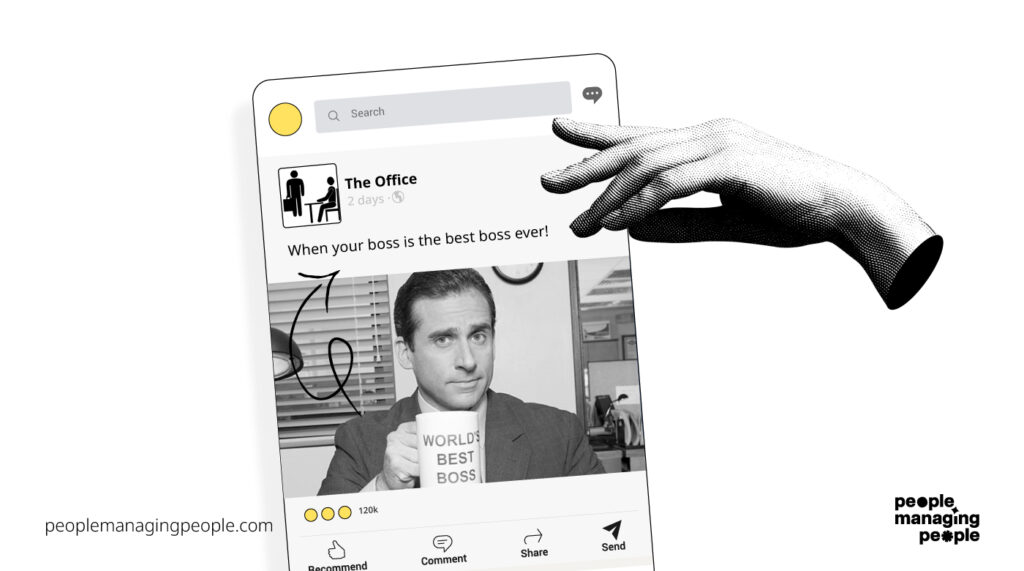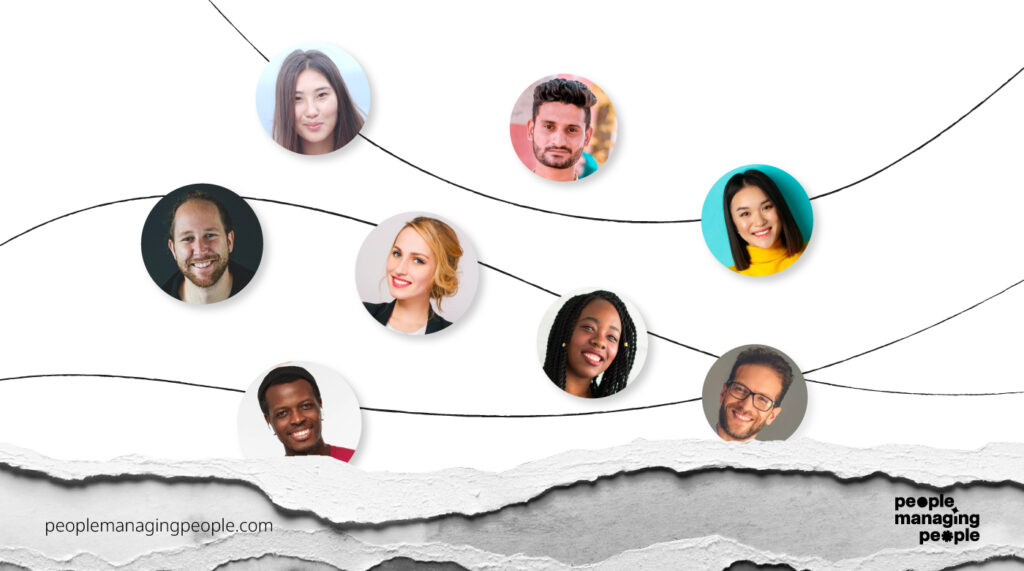Organizations are always on the lookout for talented people. As part of our interview series on hiring and engaging top talent, we spoke to seasoned HR professionals to pick their brains for ideas and insights to get ahead of the competition and attract the talent that’s right for you.
To help you out, we’ve summarized their insights into key themes.
Leverage Existing Talent For Referrals
Almost everyone we interviewed highlighted the importance of collaborative hiring and including all employees from across the org as part of the recruitment efforts.
It makes sense as current employees know your roles, needs, and company culture. Plus they’re unlikely to refer someone they don’t think will match the org or role. As well as referral schemes, you can ask current employees to share their experiences on platforms like LinkedIn and attend careers fairs.
“Current Canon employees know our company, culture, and the qualities that make people successful here, so this is a great way to start identifying talent for key positions.” - Scott Millar, Canon USA
“We have found that candidates who are referred by current Grainger team members often end up doing well when they join the company. Current team members understand what is needed and are often great at spotting talent.” - Randy Tosch, Grainger
“We've found the best way to identify and attract talent is to give your “champion” employees a voice and a platform on which to speak. They're your best bet to communicate what it’s like to work there, and your most credible source of truth.” - Eric Harris, Mindhandle
“Employee referrals are a great way to attract talent because employees are likely to refer candidates who they think will be a good fit for the company based on their experience and perception of working there.” - Weronika Niemcyzk, ABBYY
“Verizon’s most successful recruitment-related initiative so far has been genuinely sharing Verizon’s story through further amplifying the voice of our employees.” - Christina Schelling, Verizon
Frequent Communication And Collaboration Between Recruiters And Hiring Managers

Furthering the point that hiring is a collaborative process, almost all interviewees stressed the need for frequent communication between HR/recruitment teams and hiring managers.
“By approaching talent management with a blend of data and analysis, we can make informed decisions and effectively communicate them to the broader organization.” - Sarah Lovelace, Airbase
“Frequent and regular communication, translated into reports that can be analyzed, will ensure the right focus by recruiting, which results in the production of the right pool of individuals to be considered. It’s all relationship-based.” - Kirsten Renner, Accenture
“It is every people manager's job to be a recruiter. We are all talent scouts and, regardless of your function, it is critical to think about your role through this lens.” - Hollie Castro, Miro
“People and culture professionals must make it a priority to collaborate with managers and teams to understand their current and future staffing needs, as well as the skills and expertise required to meet those needs.” - Weronika Niemczyk, ABBYY
Make Use Of Modern Tools
Hiring is fast-paced and, as we’ve discovered, highly collaborative in nature. A modern hiring tech stack has the capacity to make everyone’s jobs easier and create a better experience for the candidate too.
“One of our main focus areas during the past year was to establish a strong foundation for our organization. This included implementing an HRIS system, such as Bamboo, an ATS system like Greenhouse, an analytics platform, and creating basic policies for the first time.” - Sarah Lovelace, Airbase
“To make sure we’re finding and engaging with the right talent, we additionally take a high touch-high tech approach to hiring and attracting talent. That initiative has been highly successful for us and involves the right tools and resources to deliver a positive candidate experience, including our BCGYou app for candidates looking to get more information on the firm, connect with current BCGers, apply for roles, prepare for cases, and find details on the interview process.” - Amber Grewal, Boston Consulting Group
Focus On Your Employer Brand As A Magnet

When most folks think of recruitment they think of job adverts, interviews, and recruiters reaching out to them on LinkedIn. But underpinning all this activity is the employer brand—your employer value proposition and how you’re perceived as an employer.
Your brand is crucial for attracting the kind of talent you want and should be carefully nurtured and protected.
“Employer branding is important, and we try to amplify the stories about why Miro is a great place to work. That includes having a strategy for workplace awards and telling stories about the diversity in our organization. We also rely heavily on referrals, and you need a truly great workplace for people to consider inviting their friends to join the team.” - Hollie Castro, Miro
“Attracting and engaging the best talent in an industry requires a strategic approach. One key component of this strategy is having a strong employer value proposition (EVP). An EVP is the unique set of benefits, experiences, and opportunities that your organization offers to its employees. Once you have a strong EVP that puts you ahead of your competitors in the job market.” - Weronika Niemcyzk, ABBYY
“A strong employer brand is a magnet for values-aligned talent because it doesn’t beg the candidate “Do you want a job?” Instead, it asks, “Are you like us?” That’s what we want: candidates who have self-identified as people who will succeed in the organization. Everything else is academic.” - Eric Harris, Mindhandle
Carefully Structured Interviews
As interviewing is such a crucial element of the recruitment process, it’s no surprise that they’re something our experts are hyper-vigilant about, favoring a collaborative, structured approach that effectively assesses skills and competencies.
“Conducting in-depth interviews with candidates can help to identify their strengths, skills, and experiences and determine if they are a good fit for the role. For example, at ABBYY our hiring process has changed so that more people are involved in the hiring process. The hiring managers no longer make the decision. Instead, we have created a hiring ‘group’
As a candidate, you meet with different managers—one will interview you on technical skills, another on soft skills, maybe another on leadership skills or work style, and whether you’re a good culture fit.
As a hiring manager, you need more than just data points from a 60-minute interview to get a good impression of someone’s ability and personality for the role. Now the decision and responsibility of taking on a new hire is spread between the group at ABBYY.” - Weronika Niemczyk
“When facing challenges or struggling to achieve desired results, it's essential to revisit and evaluate the process to ensure that things are being done correctly, and that qualified candidates are being identified. Similar to a sales cycle, this means being clear about what you're looking for—and not looking for—in a candidate, and having a structured interview process in place.” - Amber Grewal, Boston Consulting Group
“The first step is to identify candidate qualifications as they align to the needs of the business. We must assess talent on not only their ability to do the job, but also how their skills and values complement and add to the VTeam culture. We are able to do this by focusing on behavioral-based interviews that focus on a candidate's experience and capabilities.” - Christina Schelling, Verizon
Build A Diverse Talent Pool

Diversity is healthy in business as it is in nature. A number of the experts pointed out the advantages of drawing from a diverse candidate pool and ensuring the process is as inclusive as possible
“It’s critical to understand the current make-up of the team that the prospective candidates would be joining and seek to understand where we can continue to welcome new voices to the table. The recruiters share a toolkit with leaders that covers everything from how to identify new areas to source talent from, the importance of having a diverse interview team, and then process steps we can take to mitigate bias in everything from our job postings to the interview process.” - Randy Tosch, Grainger
“Last year we launched Accessibility@BCG, a global community to support staff with physical disabilities, neurodiverse backgrounds, chronic illness, and mental health conditions, as well as staff who are caregivers to those facing such situations. This goes along with our culture of diversity and inclusion, something we are committed to with clear actions and transparency.” - Amber Grewal, Boston Consulting Group
“In addition, Canon established its WiLL BRG—Women in Leadership Levels—which offers guidance and companionship for women in the tech industry. Led by women who have progressed through the ranks, these programs have been instituted with support from the broader organization as they help identify and attract the best candidates from a diverse group.” - Scott Millar, Canon USA
Be Transparent And Honest
Lastly, a couple of the experts stressed the importance of transparency and honesty as fundamental to a successful hiring process
“Be very honest about the pros and cons of the position, the company etc. For example, consider if the company is going through a new technology implementation or other major changes. By giving that insight, you open the door to a variety of questions that will allow you to gauge whether the person is a good candidate for the role.” - Marni Helfand, The Planet Group
“Recruiters don't need to sell jobs to people, they need to help people find the right match for themselves among the opportunities within the organization. These matches are based on a myriad of factors that are about more than a quick resume-to-req comparison. People need to feel cared for, and recruiters who believe in the missions they support are driven to make these matches come to fruition.” - Kirsten Renner, Accenture
Bonus: Improve employee retention
As a bonus, we asked the experts the strategies they use to retain workers and keep them happy and productive (which in turn feeds into the employer brand).
One strategy mentioned by almost all the experts was to listen to employees and use the feedback to shape initiatives such as hybrid working.
"Empowering employees to make suggestions on how our work environment can be improved can also serve as a significant morale boost. An example of employee feedback leading to a corporate policy shift was the support for hybrid working environments. Now, most Canon employees work from home multiple days per week. We also recently launched the Canon Intrapreneur Program – encouraging “internal entrepreneurs” within our organization to leverage new ideas and innovations from our internal talent." - Scott Millar, Canon USA
It’s the foundation of great communications. To develop an employee listening strategy at an organization, one might consider stay interviews, engagement surveys, skip-level meetings, or employee journey maps." - Eric Harris, Mindhandle
"Ensure they have the paths in front of them and that they stay challenged and fulfilled. Are you listening to your employees? Creating a growth path for them? Ensuring their needs are met? If you’d do it to convince a candidate to join, you should do it for your existing talent pool to stay!" - Kirsten Renner, Accenture
"We gather feedback from team members through surveys and round tables to understand what they need and then act based on that feedback. For example, we conduct an annual team member survey and a follow-up check-in survey, and we regularly see strong engagement close to 85% with strong participation across the business." - Randy Tosch, Grainger
Join The Conversation
Have some insights to share? You can connect with hiring experts over in the People Managing People Community, a supportive community of HR and business leaders passionate about building organizations of the future.
Some further resources:


